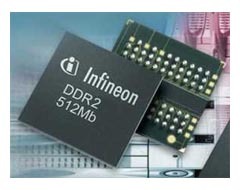Infineon, Nanya ramp production of 90 nm DDR2 memory
Munich - Infineon and Nanya have begun mass-production of DDR2 memory in a 90 nm production process. The companies believe the early introduction of the technology will offer an opportunity to catch up with market leader Samsung.
Infineon and Nanya, the fourth and sixth largest DRAM suppliers worldwide moved their DRAM production from 110 nm to 90 nm and from 200 mm to 300 mm wafers in a effort to gain cost and efficiency advantages over the previous memory generation. The new devices were developed in the framework of Inotera, a Taiwanese joint-venture run by Infineon and Nanya.
Infineon launched the production of 90 nm devices much earlier than expected. Late in 2004, the company announced it would begin shifting to 90 nm in summer of this year. According to a statement, 90 nm memories already accounted for about five percent of overall DRAM production volume in May.
512 MByte DDR2 modules are the first products to be manufactured in 90nm. 256 MByte and 1 GByte devices are scheduled to be introduced later this year. The company indicated that DDR3 memory - expected to arrive at 800 MHz speeds late in 2006 - will be launched in 90 nm as well.
Successful scaling implementations typically increase production and cost efficiency by fitting more components on one wafer. The current transition trend from 110 nm to 90 nm is considered to be critical for the competitiveness in the DRAM field. Infineon and Nanya claim to be second after Elpida in this race. However, Samsung told Tom's Hardware Guide that 90 nm 512 Mbit DDR2 has been in mass production since late January of this year, pushing Infineon and Naya to third place. "Our transition to 90 nm and below has been and will continue to be very aggressive," said Tom Quinn, senior vice president of sales and marketing at Samsung Semiconductor.
Infineon estimated Samsung's lead at about six months in 2004, which at least theoretically has been reduced to about five months with 90 nm DDR2.
Related stories:
Elpida begins production of 90 nm DDR2 memory
Micron climbs to second rank in DRAM sales, Samsung increases lead
Get Tom's Hardware's best news and in-depth reviews, straight to your inbox.

Wolfgang Gruener is an experienced professional in digital strategy and content, specializing in web strategy, content architecture, user experience, and applying AI in content operations within the insurtech industry. His previous roles include Director, Digital Strategy and Content Experience at American Eagle, Managing Editor at TG Daily, and contributing to publications like Tom's Guide and Tom's Hardware.
